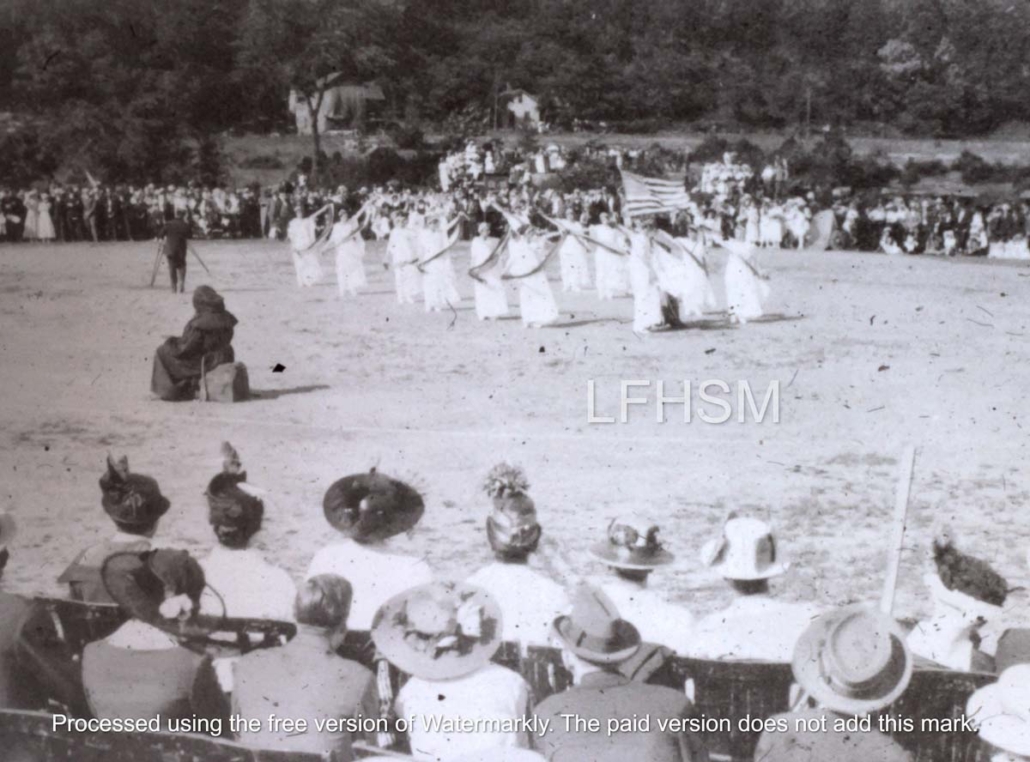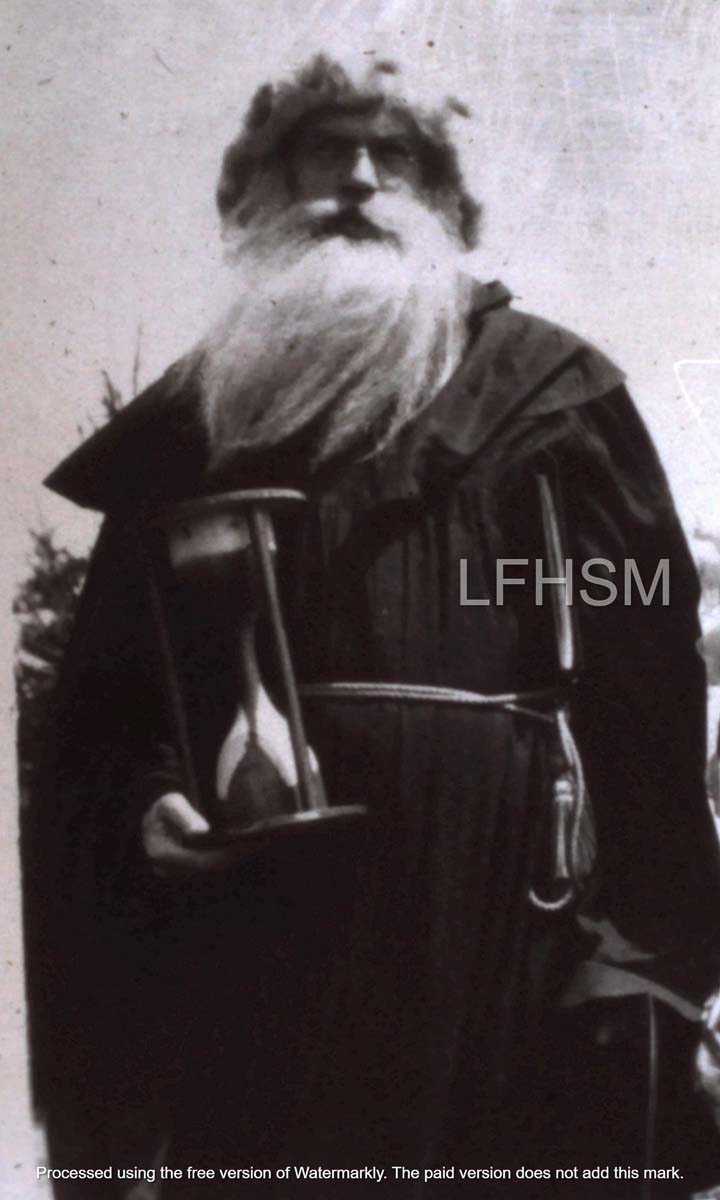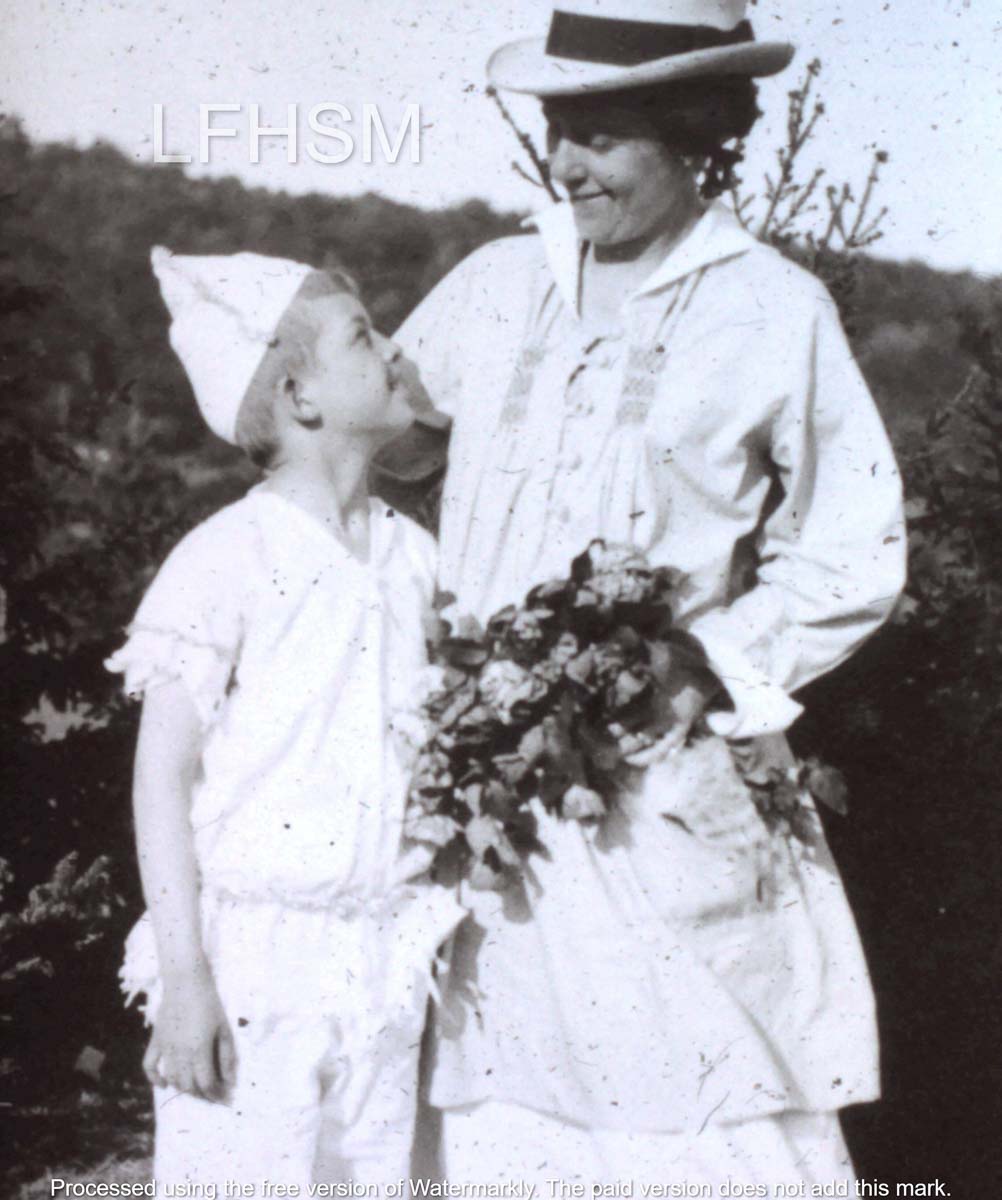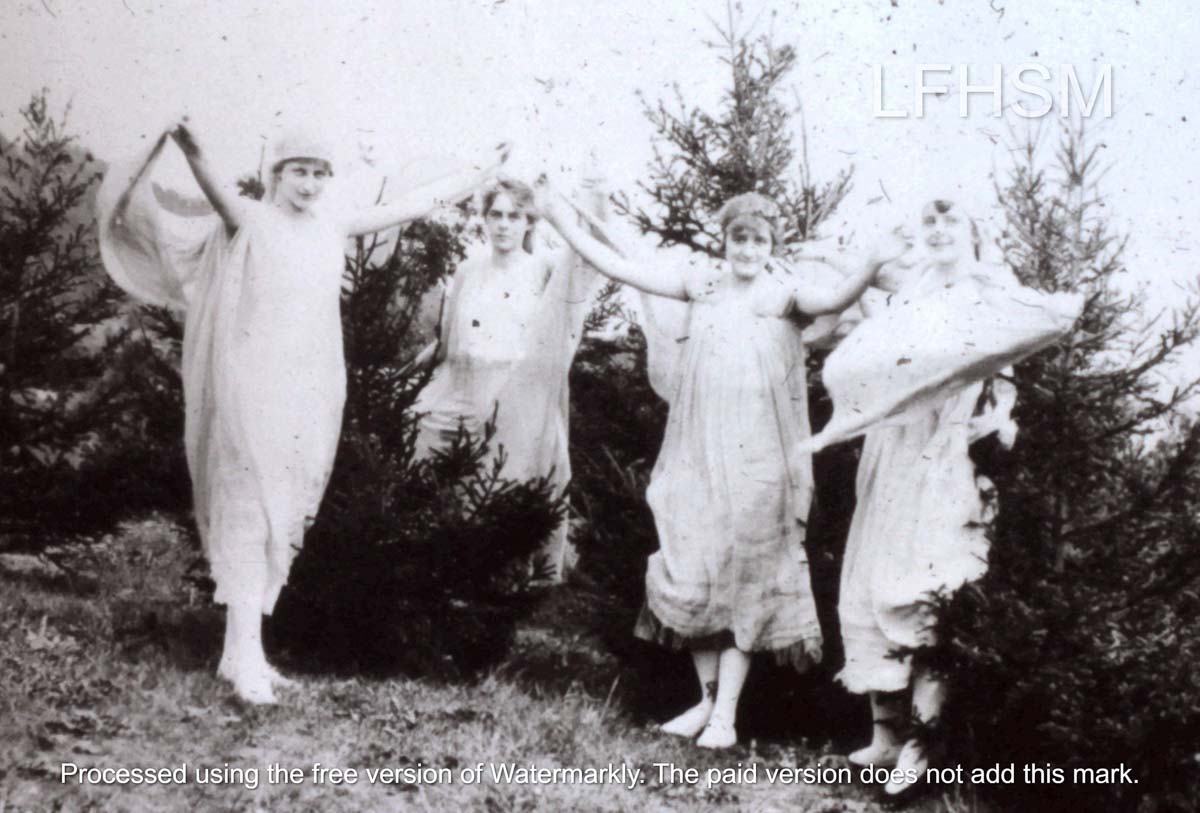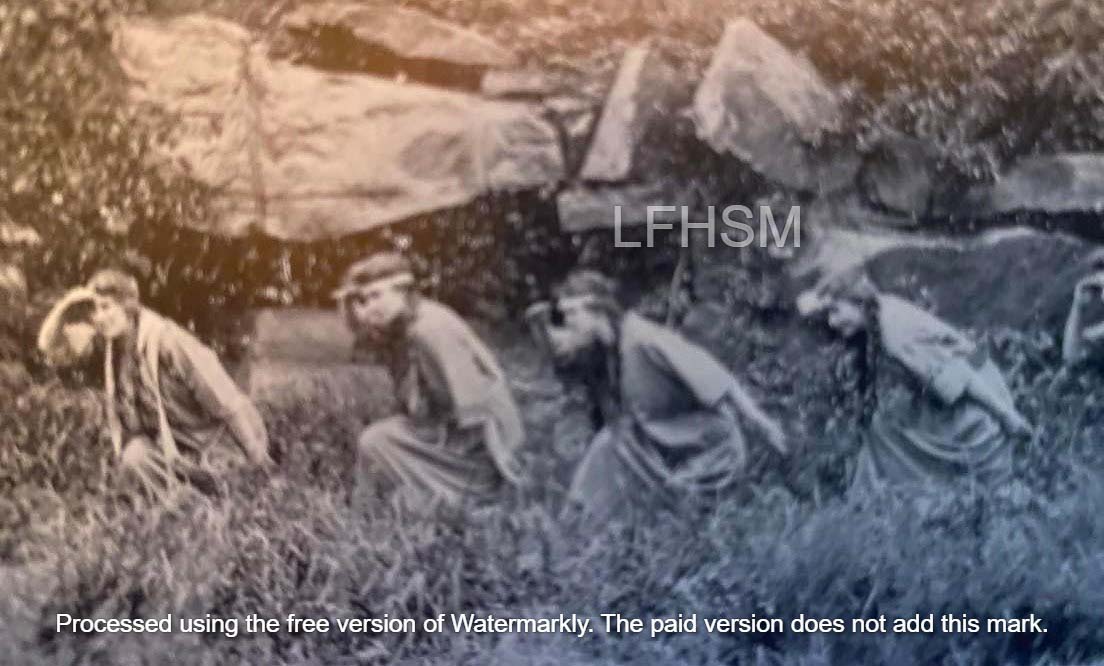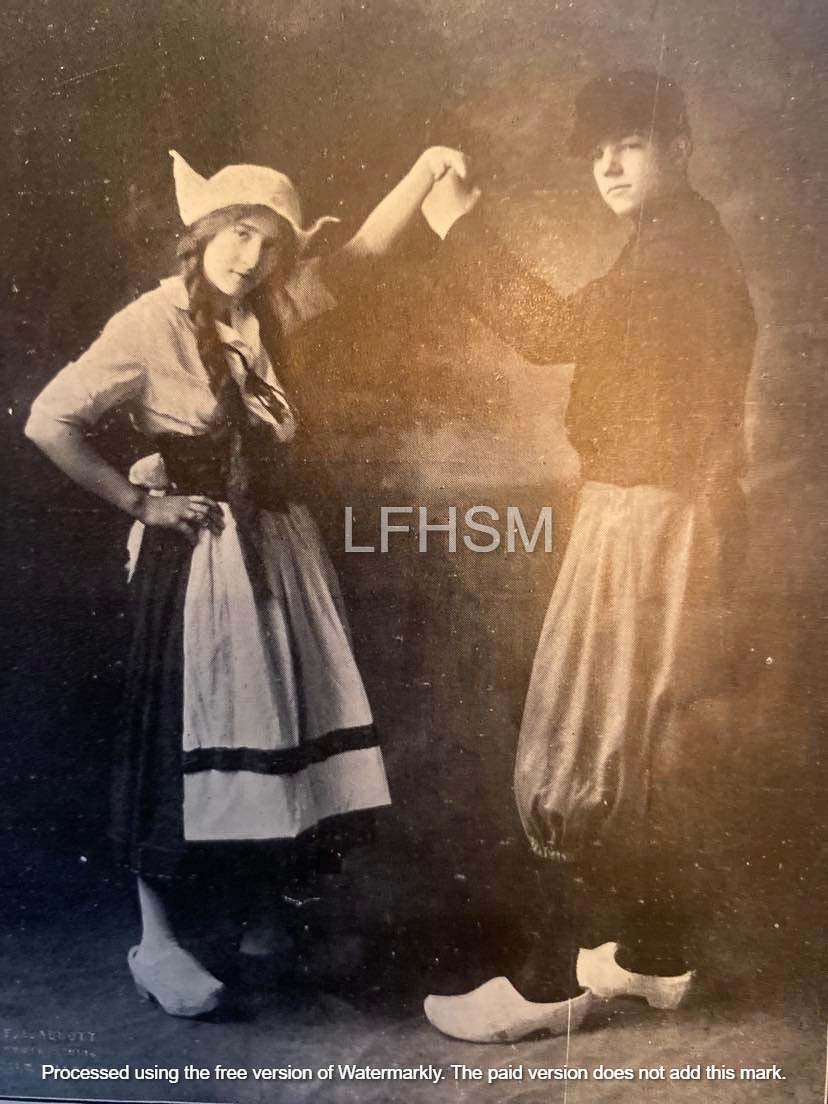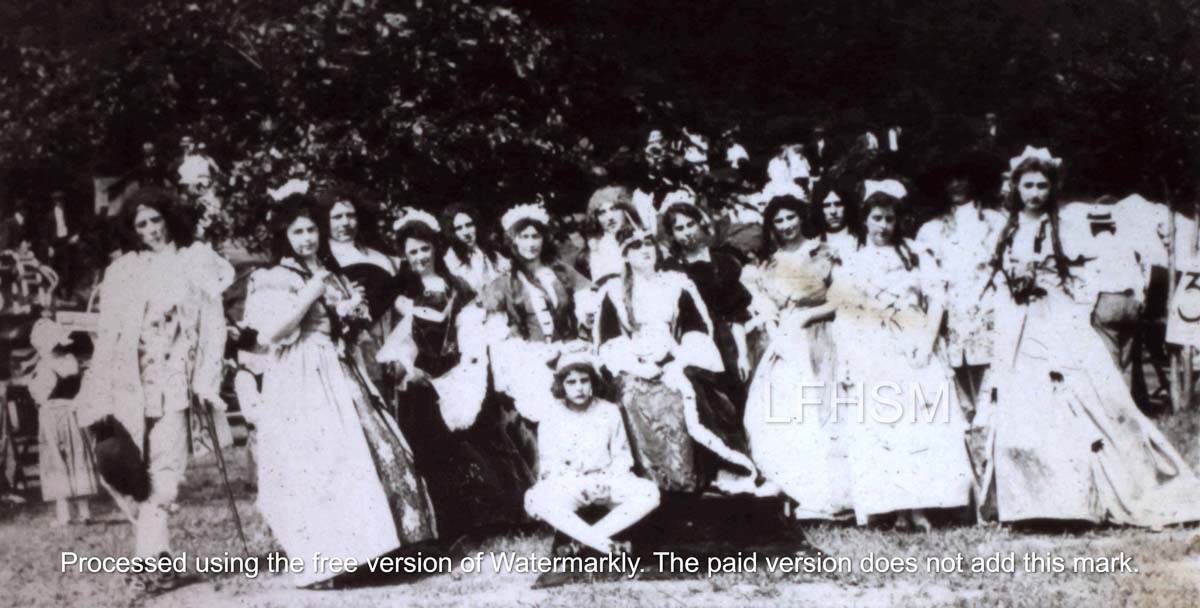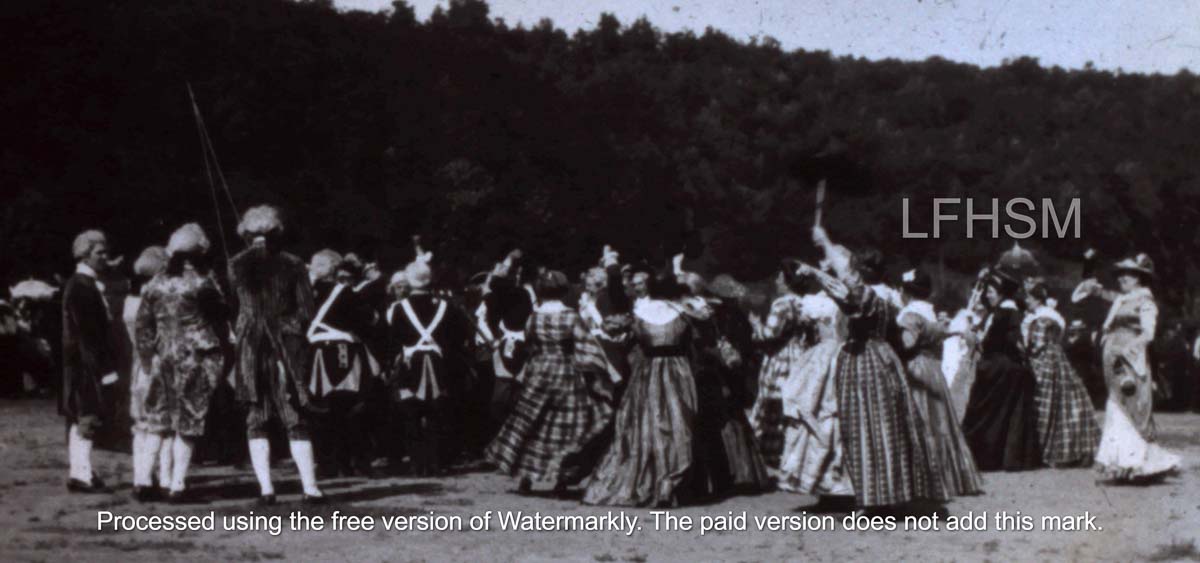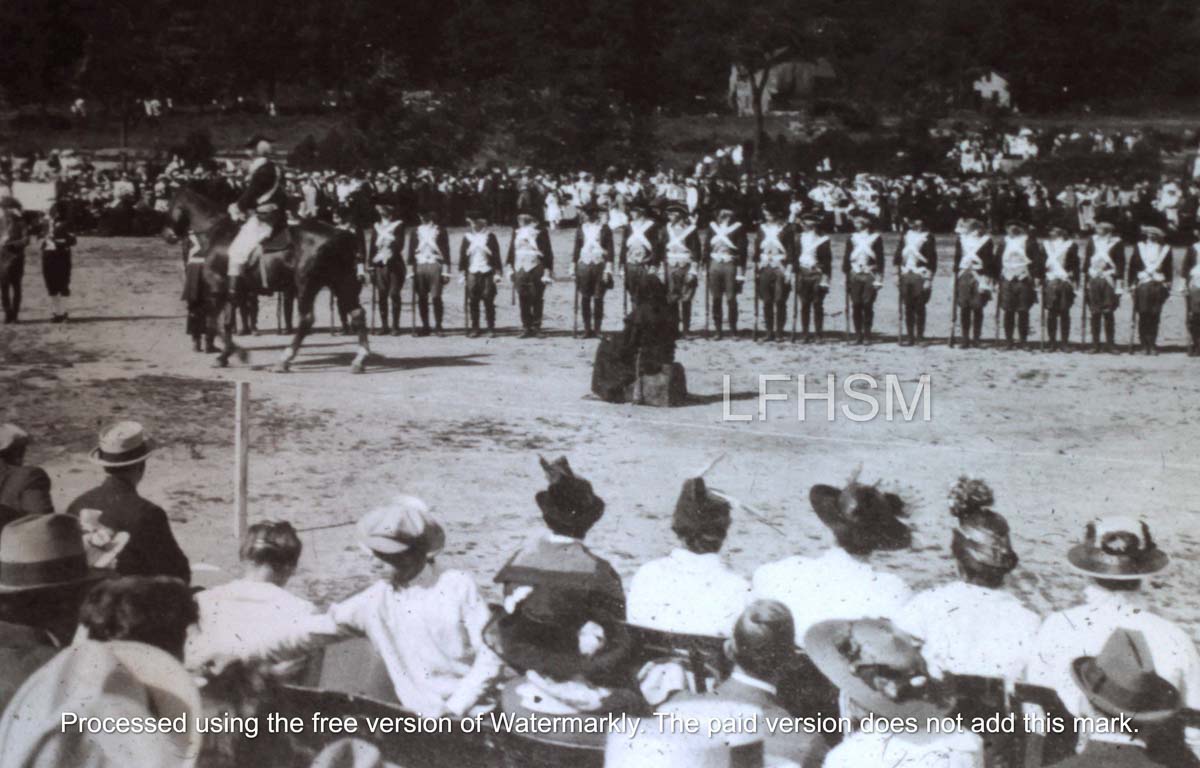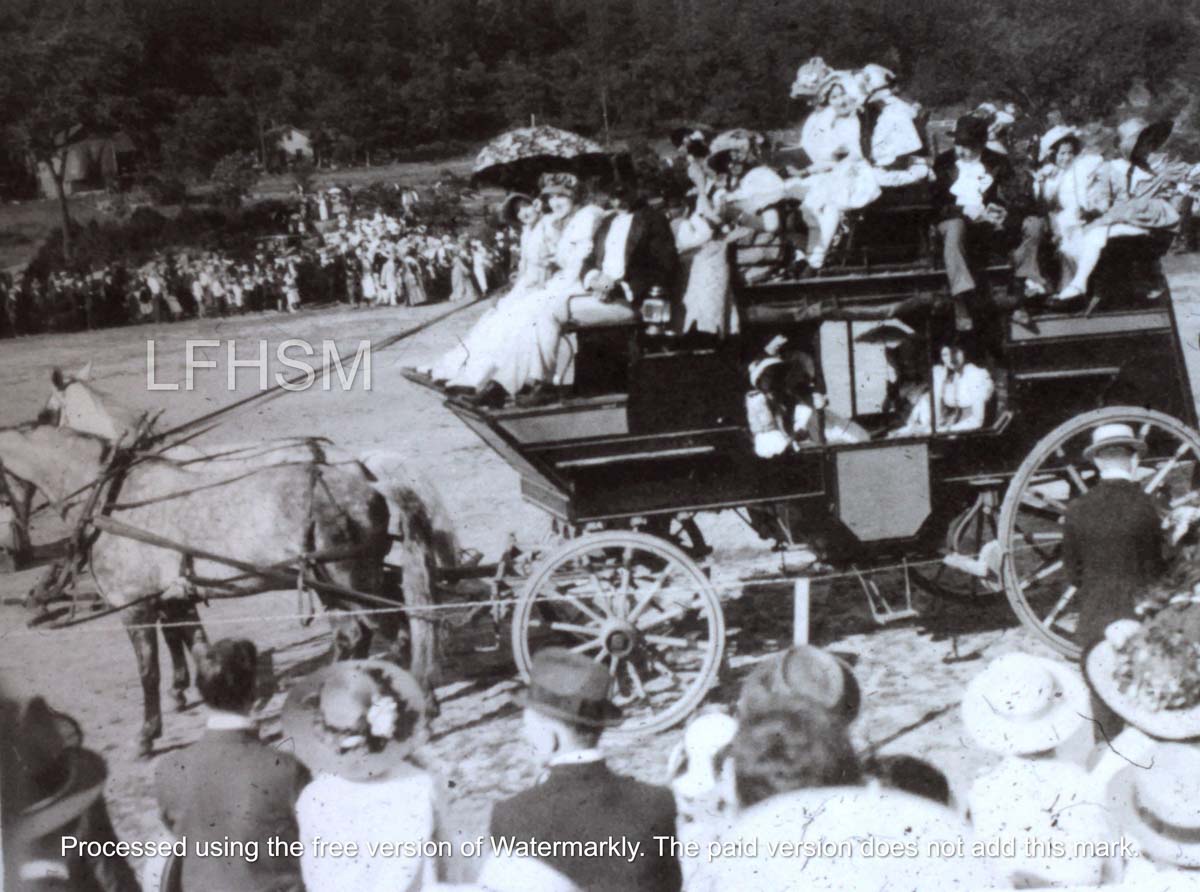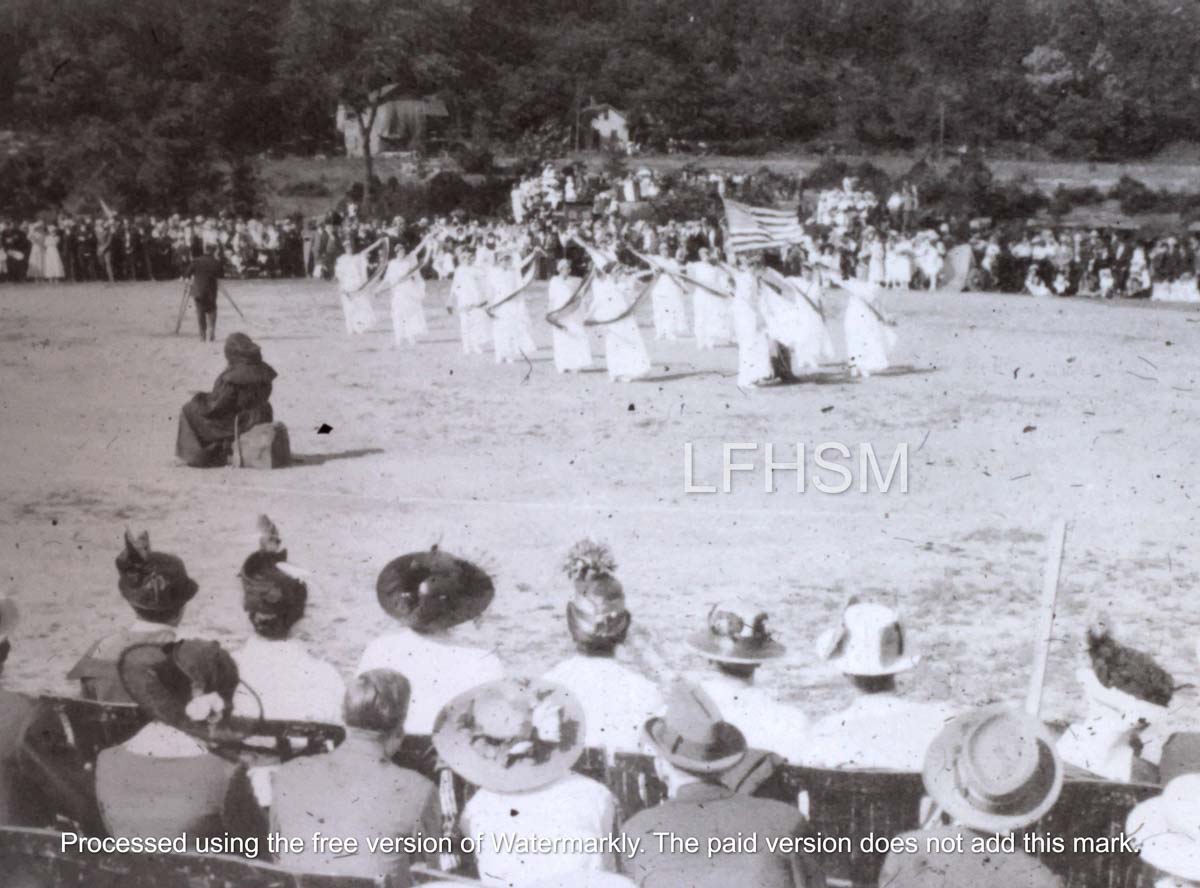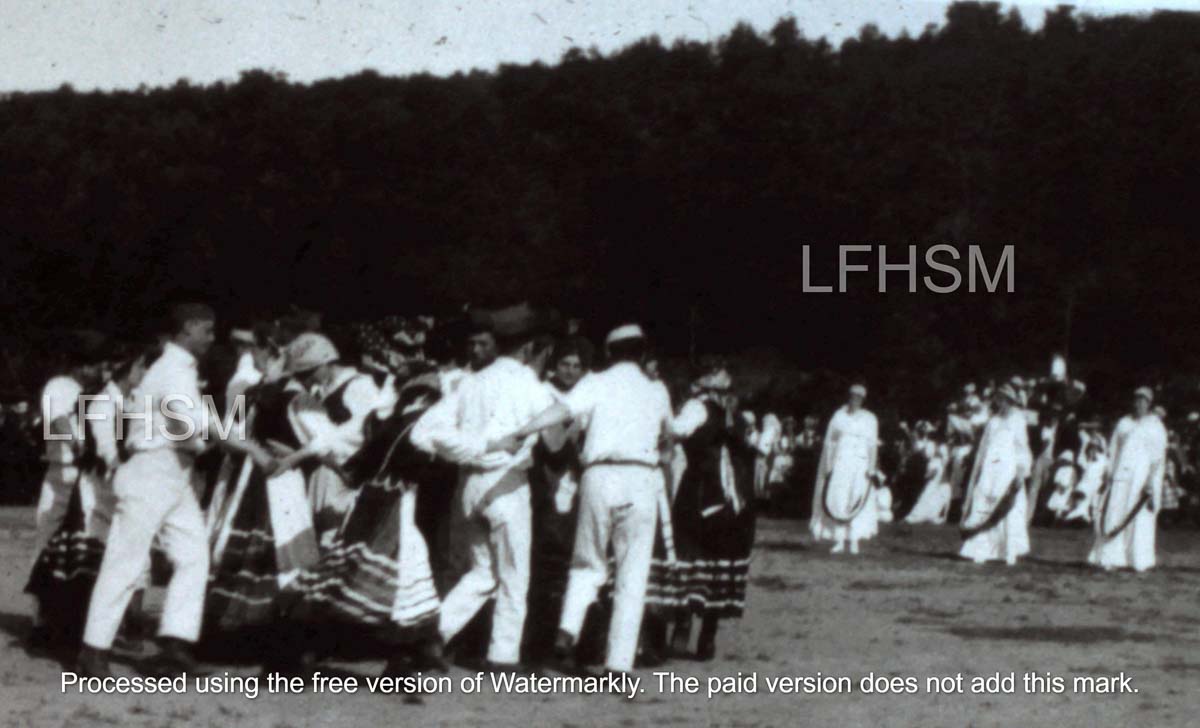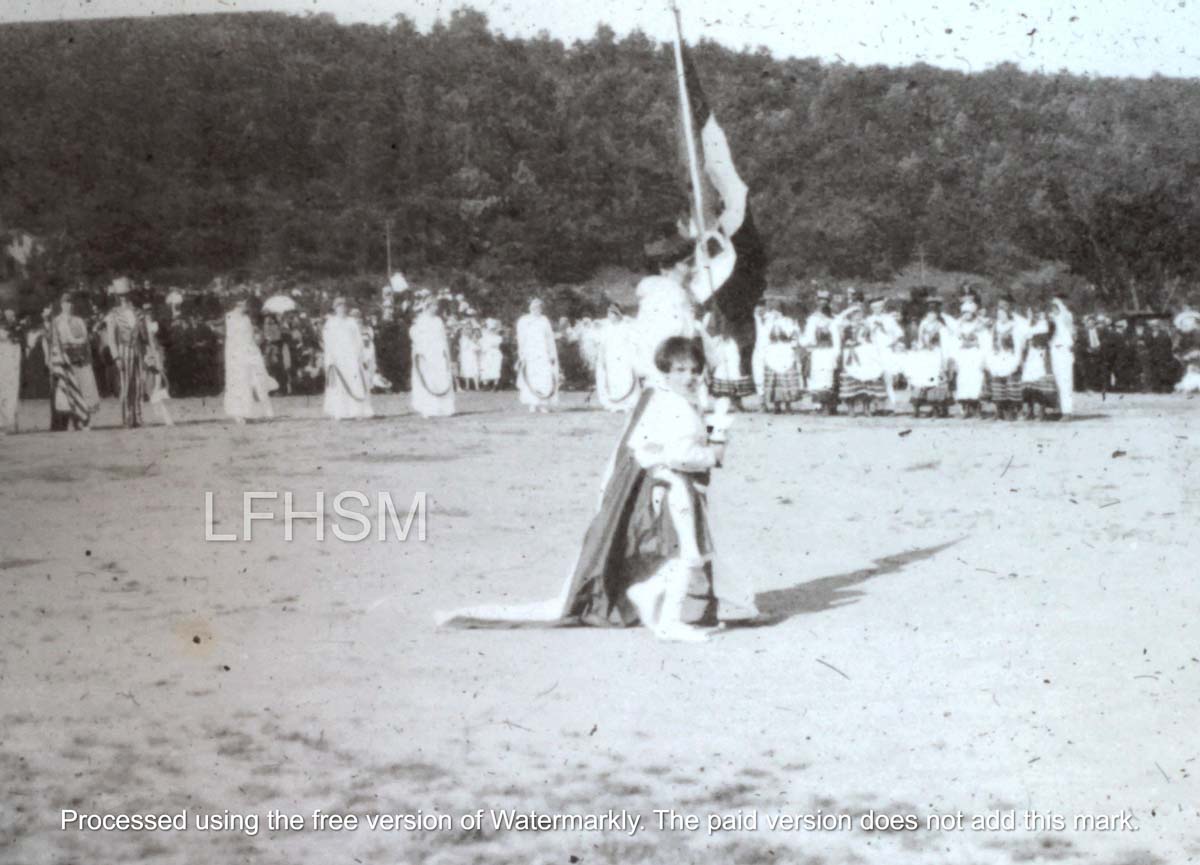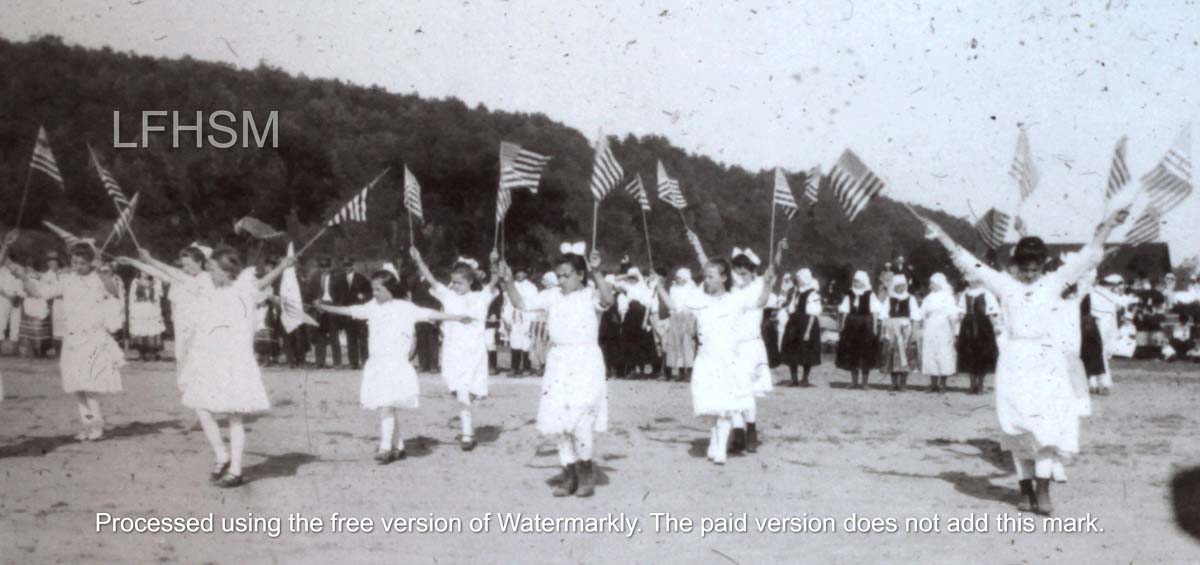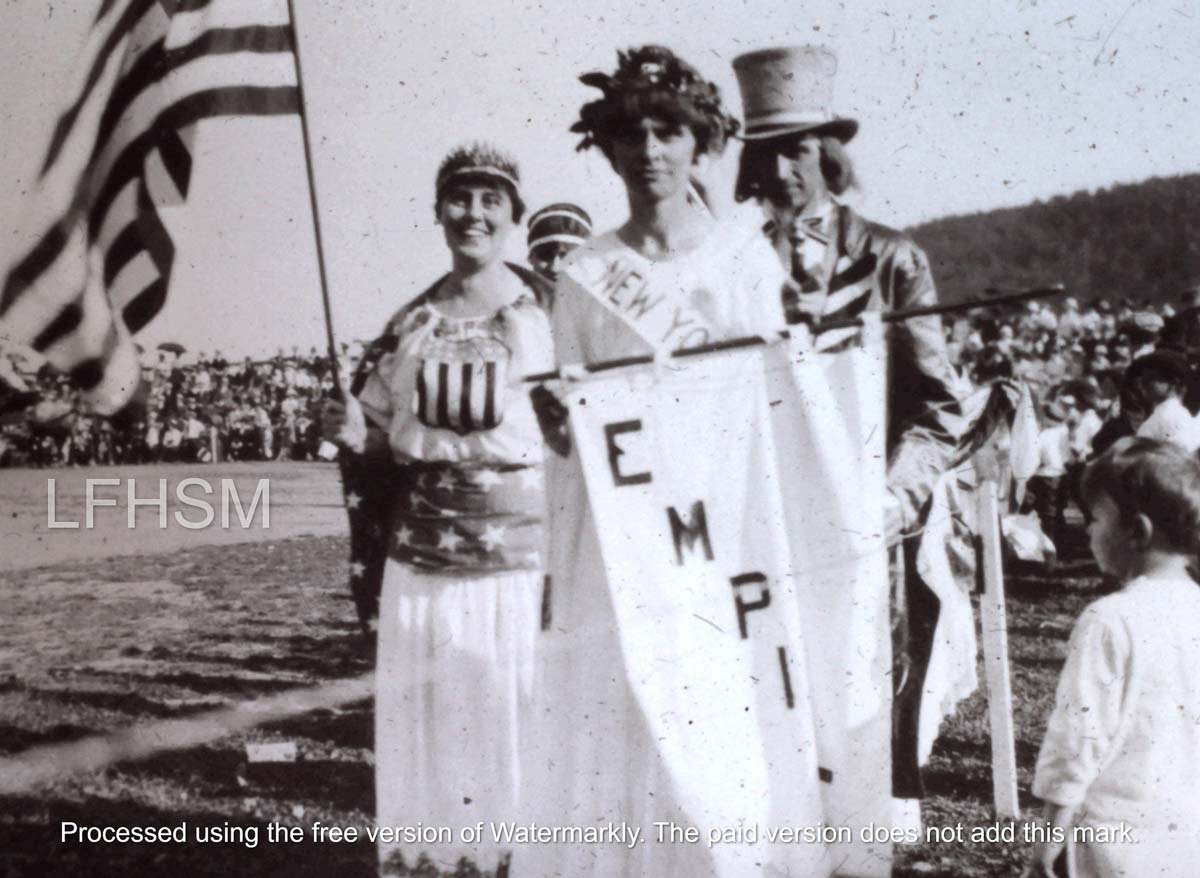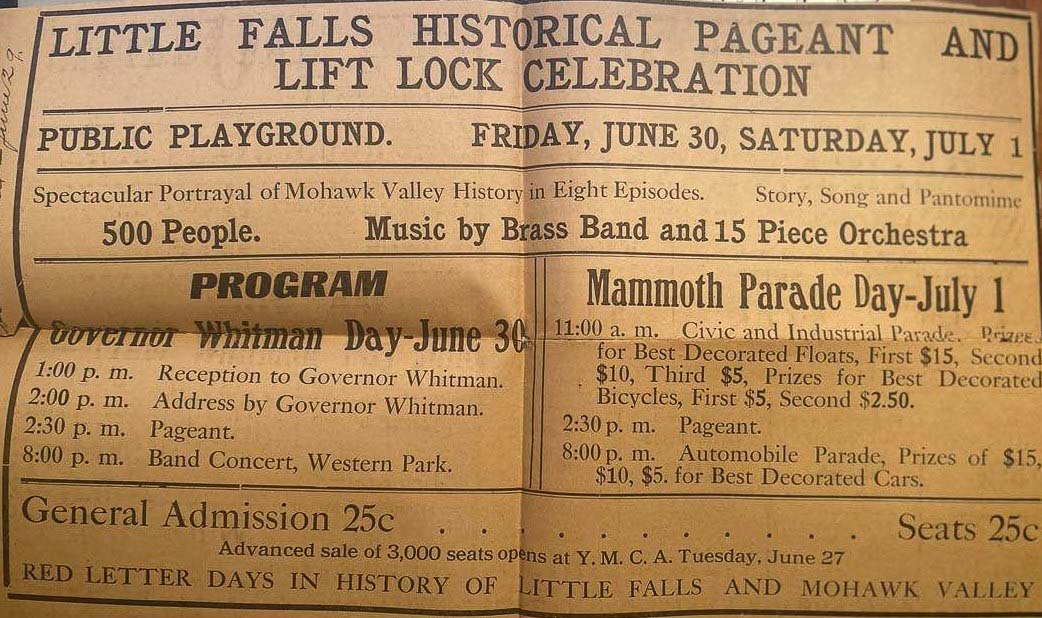ON JUNE 30, 1916, the Lift Lock Celebration began for the opening of Lock 17, the highest single lift in the Western Hemisphere at 40 ½ feet.
In conjunction with the opening, a mammoth Historical Pageant of the Mohawk Valley and a large parade were held in Little Falls.
June 30, 1916, Cooney Archives
A 1916 LIFT LOCK CELEBRATION
Under the auspices of the Y.M.C.A. and the W.C.A., the celebration included a historical pageant which was presented twice at Little Falls, in near perfect weather after a week of torrential rains, along with a civic and industrial parade, a grand automotive parade, a governor’s address and a band concert, which were all held over the course of two days on the 30th of June and the 1st of July in 1916.
The newly built lift lock, being the tallest of its kind in 1916, was an engineering marvel. The lock lifted navigating vessels 40.5 feet in height along the recently reconstructed canal at Little Falls, known as the Barge Canal. The idea of a Lift Lock Celebration to commemorate the opening of Lock 17 was first suggested by the director of the Y.M.C.A, William W. Hughes, in January of that year.
Almost every notable person within the city participated in the gala affair, with most businesses and all of the factories at Little Falls, closed for the two-day event.
An Executive Committee was formed, which included Harvey Feldmeier, an inventor who had fifty-six patents under his name and held the position of head engineer for the D.H. Burrell Company. Many sub committees were also formed, such as: a Finance Committee, which included Irving E. Stacey of the Stacey Cheese Company; the Invitation Committee, which included J.D. Frederickson, manager of the Chr. Hansen’s Laboratory; the Advertising Committee, which included Frank Simpson, president of the Felt Shoe Company and whose 1916 home was built by the well-known architect Dwight James Baum and Loomis Burrell, a son of D. H. Burrell, who became the first board chairman of the Cherry-Burrell Company; the Program Committee, which included Mrs. Louise Wing Burrell, who along with her husband Loomis Burrell, formulated a disinfectant that is similar to modern day Clorox; the Music Committee, which included Leon Dussault, who became the conductor of the Little Falls Symphony Orchestra; the Reception Committee, chaired by Mayor Abram Zoller, who is known for holding the position of Herkimer County’s Supreme Court Justice for eighteen consecutive years; and lastly, the Merchants and Manufacturers Association Committee, which included Carl J. Lundstrom, of the C.J. Lundstrom Manufacturing Company, which manufactured the Lundstrom barrister sectional bookcases. All the committees worked tirelessly together and helped produce a pageant of outstanding success.
D.H. Burrell’s wife, Louisa Loomis Burrell, a member of the Executive Committee, had approached her close friend Josephine Wilhelm Hard, to write a pageant for the celebration. Josephine W. Hard, being a historical authoress from Buffalo, N.Y., penned a script with the assistance of Louisa Burrell. The pageant was titled “Historical Pageant of the Mohawk Valley.” The script included eight episodes depicting the history of Little Falls and the surrounding Mohawk Valley, from the end of the last glacial ice age up to the present-day era for a historical pageant.
Historical pageants peaked in America, at the turn of the twentieth century. Historical pageants gave a community a way to act out their history through a dramatic performance that was educational and entertaining. The pageants, with casts of five hundred to one thousand or more performers, promoted a bond amongst those involved in the production, while also anchoring the heritage of a community.
Miss Adeline Perkins, secretary for the Y.M.C.A., acted as the pageant director and by the first of May, had rehearsals underway for performers of all ages that portrayed the cast of characters for the pageant. Over five hundred Little Falls citizens of all nationalities, out of a population of about thirteen thousand, participated in the pageant, with most being part of the cast for the production.
The Y.M.C.A. and the W.C.A. sold entry tickets to raise funds to help defray the cost of the pageant. The Finance Committee had speculated that the cost for the production was $2,500, with the elaborate costumes being a great expense.
The historical pageant held at Little Falls was performed by the use of prologues, dance, song, and pantomime, that was accompanied by music produced by a local brass band and a fifteen-piece orchestra that was conducted by Leland C. Wires.
The narrative prologue for the pageant, being written in poetry form, explained the history of Little Falls and was written by William Irving Walter of St. Johnsville, N.Y. The prologue was broken down into eight segments to correlate with the eight episodes of the production. At the opening of each episode, the chosen prologue segment was read by the character “Father Time,” portrayed by Reverend George A. Gray. (The prologue segment for each episode is included in the description of the correlating photos.) Father Time carried a large hourglass and sat upon a rock on the edge of the stage between each episode.
An invitation to the celebration was extended to Governor Charles Seymour Whitman, to be a guest of the city. He arrived aboard the Empire State Express Train at 1 p.m. on the 30th of June, at the Little Falls Railroad Depot and was greeted by a large crowd of Little Falls citizens that were cheering and waving banners of welcome, with that Friday becoming known in Little Falls as “Governor Whitman’s Day.” The governor, honoring Little Falls with his presence, was accompanied by an entourage of about twenty dignitaries from New York State and beyond. The government train stayed at the depot to await the governor’s departure, set for later that evening. The governor’s party was escorted by a motorcade to the then newly built Mohawk Valley Country Club, to a meet and greet luncheon of two-hundred guests, hosted by Congressman Homer P. Snyder. The guest list included many notables, with a few local ones being Albert G. Story, William G. Milligan, Douglas Robinson, Frank Senior, Lorenzo O. Bucklin, Walt Whitman, Dr. John M.Tanzer, and J. Judson Gilbert.
The pageant took place at the eastern end of the city at Girvan Square, presently known as Veterans Memorial Park, on a grassy plot just northeast of the baseball diamond. Two sections of elevated bleachers that could hold an audience of two thousand or more, were separated by a box built to seat the governor and his entourage. The seating was built in a semicircle with its opening facing north, where the picturesque brown rocks and shrubs formed an immediate backdrop, with the extended view of the Burnt Rocks along the Dolgeville Road being in the far background. The open-air stage was in the open space of the semicircle. Pine trees were planted on each side of the natural stage, close to the rocks, forming a screen, so that the characters had a place to await the upcoming episodes. The number of characters upon the stage for each episode varied from at least forty characters or more, with the eighth episode having one-hundred-and-twenty-four characters upon the stage.
After the luncheon, the governor and his entourage were transported by a motorcade to Girvan Park. From the governor’s box, Mayor Abram Zoller introduced Governor Whitman to the awaiting audience. The governor then proceeded to give his address.
Governor Charles Seymour Whitman’s Barge Canal Address included praising past New Yorkers and others that had the ingenuity and ambition to build the 1795 Western Inland Lock Navigation Canal, which had replaced the portage around the rapids at Little Falls and the building of the 1825 Grand Erie Canal. The newly built Barge Canal, within the evolving Mohawk River, had twenty-five times the capacity of the Old Erie. He also spoke of the large vision of Americanism that would celebrate the dawn of new growth that the Barge Canal, along with the Lift Lock, would bring to the state of New York and to the rest of the United States. He also sent out a verbal “Thank You” to all canal side villages.
The Pageant
The pageant opened to “Episode I, The Glacial Period” of the prehistory of Little Falls, with somber music being played by the orchestra, in which Leon Dussault played his violin in 1st Chair. In the prehistory, Little Falls was a mass of mist, snow and ice topped glaciers which were shown in a symbolic dance by glacial characters dressed as Spirits of Mist, Spirits of Ice, and Spirits of Snow that were costumed in different shades of whites and grays. Dancing Polar Bears then entered the stage. The glacial characters made glacial scratches upon the rocks and ground, while the dancing Polar Bears formed potholes with their sparkling gray wands of spiraling garland. After a time, the Sun-goddess, being played by Miss Lynda Billings, appeared. The Sun-goddess’s little sunbeams came upon the stage, being a group of little girls who danced merrily about her, chasing the Spirits of Ice and of Snow away with their radiant melting powers from their golden lances. Then came Spring, carrying two birds, who was played by Miss Martha Perry, with her train of buds and greens. Next, the colorful Flowers came on the stage, played by young women, that chased the remaining grayness of Little Falls away, being the Spirits of Mist, and the Polar Bears, to the sweet music of the orchestra. Spring then released her birds, closing the episode.
“Episode II, The Indian Period” began with the music taking on a more somber spirit melody of the Indigenous American Indians. A tribe of Indigenous Mohawks Indians, all in full regalia, arrived on stage with their Maidens, with one being played by Florence Vincent. The Maidens began the work of making a campfire, when fur traders, with one being played by Sydney Blumburg, arrived upon the scene carrying a canoe while pantomiming a portage. A peaceful barter of furs around the campfire took place, then a pipe of peace was shared. An Indigenous American Indian Scout approached the stage, running towards the campfire and announced that “Black Coats” were approaching. A faithful band of three French Jesuit Friars walked into the wilderness upon the stage, when their interesting history story was given by the graduating Class of 1916 of St. Mary’s Academy, since their graduation exercises were held during Friday’s performance. The New York State Commissioner of Education, Dr. John H. Finley, handed the graduates their diplomas during this scene. The Friars then tried to tell the Indigenous American Indians about the “Great Manitou of the White Men,” but the Indigenous American Indians became hostile and drove the Fur Traders away. They then bound the Friars. One of the Friars, being impersonated by William Malone, who was playing the character of the first white man at Little Falls, Father Isaac Jogues, sang “Ave Maria ” (Latin for Hail Mary) as he was taken from the stage, closing the episode.
“Episode III, The Dutch Period” pantomimed a day spent in the Dutch settlement at Schenectady, with a load of hay being merrily rolled out to the center of the stage by a group of Dutchmen, played by young men. The Dutchman characters pantomimed making hay, when Milk Maids, being a group of young women dressed in authentic Dutch costumes, tumble from the hay and out of the wagon. The Dutchmen and Milk Maids, who brought the first dairy industry to the valley, danced gracefully in their wooden shoes to a lively orchestral accompaniment, around two old Dutch Housewives. The Dutch Housewives were sitting upon the ground at center stage, trying to teach two young Indigenous American Indian Girls new skills by teaching one how to knit and the other how to attach milk cans on a yoke, When the Dutch Housewives, unable to sit idly by any longer and see time frittered away in this manner when there was work to be done, rushed about and chased the Dutch dancers off the stage, when the young Indigenous American Indian Girls gave up practicing their new skills and ran off to join the fleeing Dutch dancers, closing the episode.
“Episode IV, The English and Palatine Period” opens with a throne set for Queen Anne, played by Miss Mildred Blakeslee, who was ushered upon the scene accompanied by her Ladies in Waiting, with two of them being played by Mrs. David H. Burrell, Jr. and Mrs. Edwin A. Van Allen. The Pages spread a long length of crimson carpet as they approached the throne. Loomis Burrell, being the character of General Phillip Schuyler, along with the “Four Kings of the New World ” of the Indigenous American Indian chiefs, entered the stage upon the crimson carpet, bearing gifts of pelts and bead work for Queen Anne. Next on stage was a group of men and women, being actual Palatine descendants, portraying the characters of Palatine Settlers who were led by Hon. Myron G Bronner, who was portraying the character of Joshua Kockenthal, as their leader. The Palatines pantomimed their greetings to Queen Anne and shared their story of destitution, when the Four Kings offered land to the Palatines, with the offer being joyfully accepted. Queen Anne and her Court retire off stage, followed by the American Indigenous Indians and the Palatines, closing the episode.
“Episode V, The Colonial Period” began with the scene opening with a grand ball being given by the character of Sir William Johnson, impersonated by Dr Frederick Sabin and Molly Brant being portrayed by Miss Helen Stinson, with the character being Johnson’s common law wife, an Indigenous Mohawk Indian of the Wolf Clan. Sir William Johnson and Molly Brant, then receive a gaily attired company of twenty-four characters of Beaux and Belles, who were dressed in finery of the period and wigs of powdered hair, who proceeded to dance a graceful minuet. The guests were served refreshments, when a toast “Drink to me, only with thine eyes” was sung by a Quartette of Gentlemen, with one of the gentlemen being portrayed by David H. Burrell. As the Beaux and Belles and the gentlemen leave the stage, an Indigenous American Indian, being the character of Red Jacket, portrayed by Roy Opal, enters the stage and approaches Sir William Johnson carrying a parchment scroll. Red Jacket, Chief of the Wolf Clan, proceeds to hand Sir William Johnson the scroll, which Johnson then opens and together, they look the parchment over. Sir William Johnson then raises his right hand facing Red Jacket, pantomiming his allegiance to Red Jacket and the Indigenous American Indians, since Johnson was the British Superintendent of Indian Affairs. Two young boys, one dressed in fine colonial attire and the other one dressed as an Indigenous American Indian, portraying the Sons of Sir William Johnson, run on to the stage to Sir William Johnson’s side, when Johnson then takes the hands of the boys and escorts them off the stage, closing this episode.
“Episode VI, The Revolutionary Period” opened with the character General Nicholas Herkimer, played by Postmaster Daniel Suits, riding on horseback through the park grounds to the stage to his awaiting Troops. The orchestra was quiet during this episode, with the brass band playing fitting music of fife and drums. The General addresses his Troops and leads them in a march off the stage into the park grounds. Then a group of Patriots enter center stage, who were being portrayed by actual members of the Little Falls Sons of Veterans. The Patriots begin to pantomime the Siege of Fort Schuyler, with the building of a log fort and then the making of a crude flag by the settlers’ wives, representing the first stars and stripes of the first American Flag. Gun fire is heard off in the distance, when a Patriot Scout on horseback enters the stage to share the news that the British were defeated at the Battle of Oriskany. The episode was closed after the newly made flag was flung in the breeze, while the words to “Old Hundredth” were sung by many voices that floated over the pageant grounds.
“Episode VII, The Period of Peace” opened with a joyful dance of celebration taking place, with many Citizens celebrating the opening of Clinton’s 1825 Grand Erie Canal. F.H. Gowen entered center stage portraying George H. Feeter, who had been a lawyer, a flour merchant, and the village president when Little Falls was known as “Rockton” in the early years of Little Falls. Feeter was depicted with stately decorum as he stood by an arch on center stage that was inscribed with the words “Union of the East and West.” The East Delegate, who was representing the Citizens from the East, carried a seagull on his shoulder as he entered the right side of the stage as he walked along with a Sailor Boy, who was carrying a barrel of salt water, to center stage to greet Feeter. The West Delegate, who was representing the Citizens from the West, carried a stuffed eagle on his shoulder as he entered the left side of the stage seated upon a stagecoach, along with a Sailor Boy who was holding a barrel of fresh water, to center stage to greet Feeter. Feeter, while standing under the arch, accepted the gifts from the East and West Delegates, pantomiming the “Wedding of the Waters” as he gave the saltwater barrel to the West Delegate and the freshwater barrel to the East Delegate, closing the episode. The seagulls’ descendants, more than likely, have lived around the canalized Mohawk River ever since.
“Episode VIII, The Period of Prosperity ” was the last history episode changed by Father Time. The characters for the Thirteen States of the colonies were: Delaware; Pennsylvania; New Jersey; Georgia; Connecticut; Massachusetts; Maryland; South Carolina; New Hampshire; Virginia; New York; North Carolina; and Rhode Island. The Thirteen States characters were fittingly gowned and the character of Columbia, who was representing the United States Constitution, was portrayed by Mrs. Lela Lumley Feldmeier. The pantomiming for this episode portrayed all thirteen colonies as states accepting the United States Constitution, all being ratified into the Union, with the joining of Rhode Island in 1790. The stage then became filled with over one-hundred characters of many different nationalities. The pantomime then portrayed all the ethnic characters of this group becoming New American Citizens by accepting the United States Constitution by greeting Columbia and then greeting the Thirteen States, where all nationalities made a true America. The New American Citizen characters were actual immigrants of Polish, Italian, and Slovakian heritage. The New American Citizens were costumed in their native dress, bringing gifts and presenting their folk dances and songs to Olympia and the characters of the Thirteen States. Wicenty Cybulski led the Polish as a delegate being the character Spirit of Poland, with the group giving a Polish march and dance. Mrs. James Castalda portrayed the character Spirit of Italy as a delegate for the Italians, with the men of the Italian group playing guitars and the women of the Italian group playing tambourines. Albetza Mocko and Pavel Stefcik were the Bride and Groom characters of a Slovakian wedding party and were the delegates for the Slovakian group. A troupe of little girls, who were actual members of the multiethnic Pollyanna Club of Little Falls, played the characters as Pollyanna’s, with each bearing two American flags. The Pollyanna’s advanced to the center of the stage and skillfully went through the maneuvers of a beautiful flag drill.
Friday’s show of the historic pageant was closed when the character of Uncle Sam, portrayed by Conrad Oliver, rushed down from the audience to stand by Columbia and the Thirteen States, when everyone within the cast of the pageant then sang “America.”
The governor, along with his entourage, exclaimed that they were more than pleased with the performance of the production. It was estimated that there were well over two thousand spectators at Friday’s showing of the Historical Pageant of the Mohawk Valley.
At 8 p.m. that evening, a band concert was held at Western Park. Governor Whitman and his entourage were escorted by motorcade to their awaiting train when the music ended for the evening.
At 11 a.m. on Saturday morning, the 1st of July, a grand civic and industrial parade led by James “Dusty” Long, paraded throughout the city. The parade was divided into five sections, with each section being led by a marching band. The decorated floats throughout the parade represented many of the businesses and manufacturers of Little Falls. All of Main Street was festively decorated for the occasion, as well as the other streets included on the parade route. The parade started on John Street and continued: to Alexander; to Burwell; to Gansevoort; to Main; to West Main; to Lock; and countermarched to Ward Square. Prizes were given to the top three of the best decorated floats.
The second show of the pageant was shown at 2:30 p.m. that afternoon at Girvan Park. Nearly one hundred automobiles were parked on the grounds of the park, which were filled with families ready to enjoy the show. The audience in attendance was just as large, or if not larger than it was for Friday’s show.
As the last episode of the Historic Pageant of the Mohawk Valley was closing, a grand march began with the full cast of characters of the production. They proceeded to parade throughout the park, bringing the historical pageant to a close. An estimated five thousand people viewed the pageant over the two-day event.
A grand automotive parade was held that evening at 8 p.m., with well over one hundred autos being led by Fire Chief Edward J. Cooney, parading through the streets of the city. The automotive parade was sponsored by the Automobile Club of Little Falls, chaired by General William F. Lansing, who was a lawyer in the office of Judge Rollin Smith. Prizes were given to the top three of the best decorated automobiles.
Nothing so elaborate, so artistic, and so successful, has ever taken place in Little Falls as the Lift Lock Celebration. We continue to celebrate our pride in community and our canal history with a Canal Days Celebration, which has been held each August since 1987. The 2023 Canal Day Celebration will be held from August 7-13, so hoping you will be a guest of Little Falls and join the celebration!
*Digitizing of Historical Photos by Gail & Mike Potter, FROM THE COONEY ARCHIVES: THIS DAY IN HISTORY by Louis Baum, JR, Article written by Darlene Smith
SOURCES: Historical Newspapers & a historical brochure that was handed out during the actual 1916 celebration
To learn more about the “Historical Pageant of the Mohawk Valley” and pageant history, please view the WRITING SERIES: The Little Falls Lock 17 Dedication Celebration of 1916 by Angela Harris. which can be found at: https://littlefallshistoricalsociety.org/…/the-little…/
Please view the AUDIO TOUR of “Lock 17” by Kaitlin Miller of the Cooperstown Museum Studies Graduate Program, Suny Oneonta, which can be viewed at: https://littlefallshistoricalsociety.org/…/lock-17…/
Please view the AUDIO TOUR of “The Barge Canal’s Influence” By Zac Greenfield of the Cooperstown Museum Studies Graduate Program, Suny Oneonta, which can be viewed at: https://littlefallshistoricalsociety.org/…/the-barge…/
The Little Falls Historical Society Museum is open for the 2023 SEASON, with FREE TOURS on Mondays, Wednesdays, and Fridays from 1pm-4pm. The museum will also be open on alternating Saturdays, from 9AM-Noon (started June 3rd). We are still accepting “Appointments for After Hours”– for an appointment, please contact Louis Baum at 315-867-3527. Plan a visit to stop by the museum for a free tour!!

